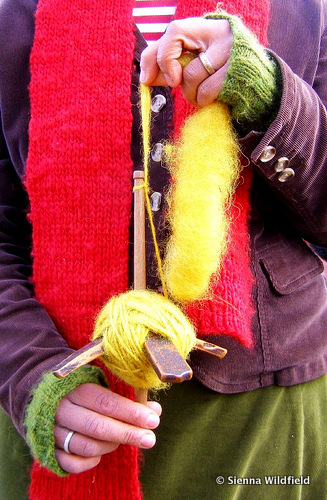Knitting Supports Explorations of History, Agriculture & Mathematics
Cast On for Explorations of Math, Local History, and Service-Based Learning Through Knitting

An age-old skill, knitting provides us with some of our most treasured warm clothes. Learning the art of knitting can not only help to provide warmth, but can lead to explorations of local history, local agriculture, and complex math – and families can even engage in service-based learning by donating hand-knitted goods to help support people in need!
Winter means the wearing of layers – some of our most treasured of which have been hand-knitted with love. Mittens from nana, sweaters from mum, scarves from caring neighbors – all of these handmade warmth-giving items are precious, not only because of the love and care that went into making them, but because of their connection to our agrarian history and the learning opportunities that they can spark. Learning to knit (whether self-taught or guided by an expert) is a creative endeavor like no other, and can lead to explorations of history, culture, complex mathematical concepts, art, and even service-based learning!
Drawing upon western Massachusetts’ rich fiber culture, families can find numerous resources to support knitting-based studies of sheep and shepherding. While sheep usually steal the springtime barnyard show, sheep-based learning can take place any time of year with a few skeins of yarn and some needles! Once upon a time, all yarn would have come from hand-carded wool and been hand-spun, but these days, most woolen yarn is processed in a factory. Nevertheless, it’s still possible to get locally-sourced yarns (and even hand-spun local yarns!) by doing a little research and shopping locally. CISA offers a list of nearly twenty fiber-producing farms in western MA, proving that the tradition of local wool is still alive today!
Once you’ve found some great yarn, it might be time to work on knitting skills. While there are infinite how-to videos available online and nearly as many instructional books available, oftentimes a real life human can be the best support for new knitters. Intergenerational drop-in knitting circles are offered at a handful of libraries, offering not only free knitting classes, but a knitting-centric community in which to work and gain insight from more experienced knitters (expect support rather than instruction). Additional knitting groups (and classes, for a fee) are available at Sheep to Shawl in South Deerfield and WEBS in Northampton, but these events are best for self-directed teens and adults rather than young children.

While working on knitting skills, families will learn to use patterns in order to create woolen goods. Even something as simple as a scarf requires attention to numerical details, and more complex patterns like mittens fitted to a particular hand and covered in snowflake designs most certainly require math! The math inherent to the type of knitting that most children are able to do is somewhat basic, but exposure to its use can help to solidify young knitters’ understanding of unit conversations, scale, and area. Knitting math is accessible to any knitter who can add, subtract, multiply, and divide – even if they’re using a calculator to do so. Knitting helps to give context to the somewhat abstract concepts attached to these skills, as knitters will understand exactly why they perform each calculation necessary to complete their creation. Exploring bigger mathematical concepts through the lens of knitting can even reveal some surprising creations – British former teachers and master knitters at Woolly Thoughts have knitted all things mathematical, including endless illusions and some Fibonacci-inspired designs, too.
In addition to leading to learning about local history, local agriculture, and math, knitting lends itself nicely to service-based learning, too! There are countless organizations that collect hand-knitted items for a variety of causes, and creating hats, scarves, mittens, blankets, or other hand-knitted items for people in need can be an incredibly valuable and rewarding experience for young knitters. Organizations to support should be chosen based on knitters’ ability to create the goods desired, but more skilled knitters can probably choose any organization! Scarves, an easy creation for new knitters, can be donated to Operation Gratitude’s Scarves for Troops program, which sends handmade scarves to troops serving overseas. Hand-knitted hats can be donated to Hats 4 the Homeless and to specific causes supported by Warm up America. Blankets and afghans, while quite a feat to create, can make a great collaborative family project and can be donated to Project Linus or Help Our Kids, which supports foster children here in western Massachusetts. Afghans for Afghans collects a variety of knitted goods, including socks, hats, and blankets, and will be conducting a new collection campaign in 2016 – start knitting now and check back in a few months!
[Photo credits: (c) Sienna Wildfield; (cc) Evan Long]
 Hilltown Families
Hilltown Families 




























